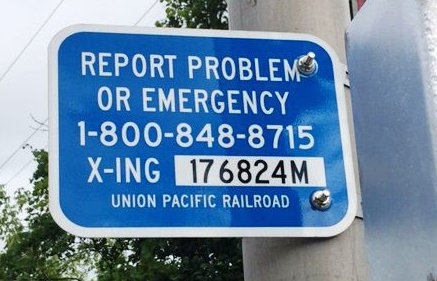
Prompt reporting helps keep everyone safe. To help ensure a quick and accurate response, be ready to provide the following details:
- Street or highway name where the crossing is located
- Nearest city or town
- DOT Crossing Number (if available) – a six-digit number followed by a letter (e.g., 999 999A), typically found on the blue sign mounted on the crossbuck post, signal mast, or signal cabinet
Know Your Railroad Crossings
Two Types of Crossings
- Public Crossings: Found on roads maintained by public agencies. Marked with signs or signals.
- Private Crossings: Located on privately maintained roads. May lack warning signs or markings.
Two Types of Warnings
- Passive Warnings: Signs and pavement markings like the yellow advance warning sign, white crossbuck, and stop/yield signs.
- Active Warnings: Flashing lights and gates that activate when a train approaches. Installed based on traffic, train frequency, and safety data.
Your Frequently Asked Questions
Why Do Engineers Sound Train Horns?
Train horns are required by federal law to sound at least 15 seconds before entering a crossing – for your safety and theirs.
Who Maintains Crossing Signals?
Railroads maintain active warning systems. Local road authorities handle signs like stop, yield and pavement markings.
When was the Signal System put into place?
Railroad warning technology dates back to 1870. The track circuit – still in use today – was a game-changer for train safety.
How are railroad crossing signal locations determined?
The placement of active warning signals – such as gates and flashing lights – at railroad crossings is part of a federally guided process led by state transportation agencies, not the railroads themselves. The safest crossing is no crossing. We continue working with communities and agencies to close redundant crossings wherever feasible.
- Federal Oversight: The Federal Highway Administration classifies crossing signals as highway control devices, meaning they fall under highway – not railroad – jurisdiction.
- State Responsibility: Each state receives an annual allocation of federal funds and uses its own system to prioritize crossing improvements. Factors typically include:
- Vehicle traffic volume
- Types of vehicles using the crossing
- Number of daily trains
- Collision history
From Selection to Installation:
- The state identifies crossings for improvement.
- It contacts the railroad to schedule a joint on-site ‘diagnostic review meeting.
- The railroad designs the signal system and provides a cost estimate.
- The state reviews and approves the plan, then authorizes the railroad to proceed.
Who pays for signals?
Most signal installations and upgrades are funded through federal safety programs, historically known as Section 130 funding. Installation costs vary depending on the complexity of the crossing and the level of equipment needed to meet safety standards. In areas where grade separations (such as underpasses or overpasses) are planned, funding sources and total costs also vary based on site conditions.
Report Rail-Related Emergencies
Report emergencies or suspicious activity on or near the tracks to Union Pacific. For matters that are not life threatening, contact us online.
- Emergency Numbers
888-UPRR-COP (877-7267)
00-1-881-877-726
Dial 7-1-1 for Telecommunications Relay Services

